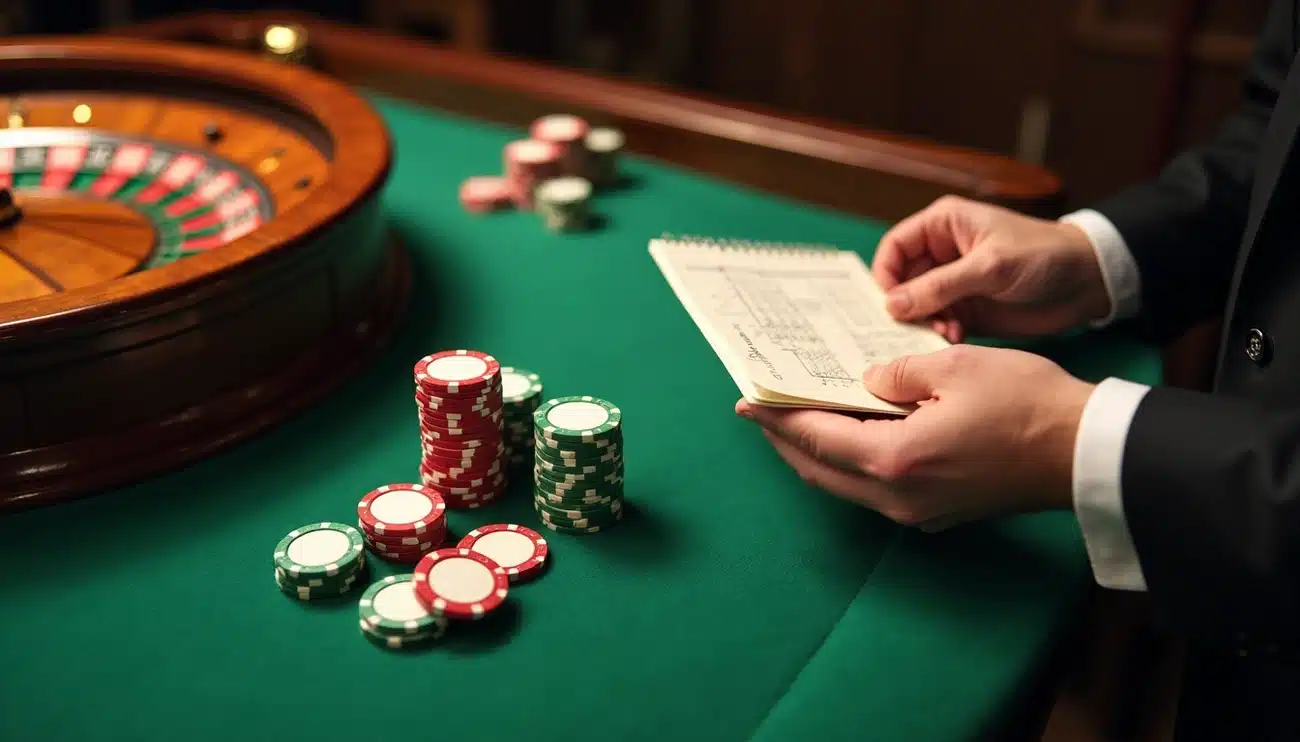The Labouchere Betting System – Let me share something surprising about the Labouchere strategy – you need to win just one-third of your bets to make a profit. The system works so well that you can lose twice as often as you win and still come out ahead!
The Labouchere system caught my attention when I discovered its rich history. British politician and gambler Henry Du Pre Labouchere created this strategy, also known as the Split Martingale or Cancellation system, back in the 1800s. The system shines best with even-money bets offering close to 50/50 odds, making it ideal for roulette, baccarat, and select sports betting markets.
The sort of thing I love about the Labouchere roulette system is its unique approach to profit targeting through number sequences. A player wanting to earn $20 might use a sequence like 2, 3, 3, 5, 7 that adds up to their target amount.
The system falls under negative progression betting, which means higher stakes follow losses. Players can recover from setbacks this way, but they must manage their bankroll carefully. Research shows that with 1000 units in your bankroll, you’ll typically need 21 bets to hit your winning target.
Some players might find the standard approach challenging. The good news? You can explore the reverse Labouchere system or try Labouchere betting system calculators that simplify everything. Ready to explore this fascinating betting strategy step by step?
What is the Labouchere Betting System?
“this is a system that starts with the bettor writing down a sequence of numbers” — TopFootballBettingSites, Sports betting analysis platform
The Labouchere system ranks among the most mathematically fascinating betting strategies gamblers can use. This system doesn’t use simple multipliers like others do. Instead, it uses number sequences that shape your betting patterns.
A British aristocrat and politician named Henry Labouchere, who loved playing roulette, gave this betting system its name in the 19th century. His grandson’s biography tells an interesting story – Labouchere didn’t create the system. He found it in a letter written by French mathematician Marie Jean Antoine Nicolas de Caritat, Marquis of Condorcet.
The system’s main idea uses number sequences that add up to your target profit. You calculate each bet by adding the first and last numbers in your sequence. A win lets you cross off these numbers, while a loss means you add your lost bet amount to the sequence end. People call it the cancellation system because you cross off numbers after winning.
How does it compare to other betting systems?
The Labouchere system is different from other betting strategies. It works as a negative progression system, much like the Martingale, where bets increase after losses. Notwithstanding that, one vital difference exists: the Martingale tries to win back all losses in one go, while the Labouchere does it through several wins.
On top of that, it gives players more options than other systems. Players can create their own number sequences based on their money goals and risk comfort. The system’s well-laid-out approach helps reduce snap decisions that often happen while gambling.
The system’s biggest advantage might be that you don’t need to win all your bets. The math shows you only need to win about one-third of your bets plus two more to make money. This makes it great for even-money bets like red/black in roulette or sports betting markets with close to 50/50 odds.
Why is it called the cancellation system
The system got its “cancellation” nickname from its method of crossing off numbers from your sequence after each win. This cancellation process drives the whole strategy.
Let’s look at an example with the sequence 1-2-3-4-5. Your first bet would be 1+5=6 units. A win means you cancel 1 and 5, leaving 2-3-4. Your next bet becomes 2+4=6 units. But if you lose, you add your lost bet amount to the sequence end, making it longer.
The cancellation approach’s math is clever. You cross off two numbers after winning but add only one after losing. This means you can finish your sequence and hit your profit target even with more losses than wins. Many other systems need you to win at least half your bets, but this one works differently.
The system has its risks. Long losing streaks can make your bets grow too large and drain your bankroll. The math might look good, but you need enough money to handle losses while waiting for the system to work.
How the Labouchere System Works Step-by-Step
The Labouchere system needs five simple steps that create a smart betting approach. Let me show you how this strategy works best with even-money bets.
Step 1: Set your profit goal
My first task is deciding the exact amount I want to win in one cycle. This target amount builds the foundation of the whole strategy. The right profit target should:
- Match my bankroll size
- Show my risk comfort level
- Split easily into smaller numbers
To name just one example, a £20 target would work well. This goal-focused method sets the Labouchere system apart from random betting since it gives me a clear finish line for each sequence.
Step 2: Create your number sequence
My profit goal needs to be broken down into at least three smaller numbers that add up to my target. I can structure this sequence any way I want.
Here’s how I might break down a £20 profit goal:
- 6, 2, 3, 3, 2, 4 (adds up to 20)
- 1, 2, 3, 4, 5, 5 (adds up to 20)
- 2, 3, 5, 10 (adds up to 20)
Short sequences with smaller numbers make it easier to finish the cycle. Longer ones spread out the risk but might take more time.
Step 3: Place your first bet
Once I have my sequence, I add the first and last numbers to get my first bet amount. A sequence like 1-2-3 means my first stake would be $4 (1+3).
This bet works only on even-money options like:
- Red/black in roulette
- Odd/even in roulette
- Pass/don’t pass in craps
- Player/banker in baccarat
- Sports bets with close to even odds
The math behind this formula creates a system that makes sense throughout the betting sequence.
Step 4: Adjust the sequence after each result
Each bet result changes my sequence:
If I win, I remove both numbers used in my stake calculation. With our 1-2-3 example, winning the first bet means crossing out 1 and 3, leaving just 2 for the next bet.
If I lose, the lost bet amount goes to the end of my sequence. Losing that $4 bet turns my sequence into 1-2-3-4, making my next bet $5 (1+4).
This adjustment method explains why people call it the “cancellation system” and shows its mathematical core.
Step 5: Repeat until the sequence ends
I keep going – betting first plus last numbers and adjusting after each bet – until:
- My sequence has no numbers left, meaning I hit my profit target
- I reach my money limit for the session
- My time runs out
Success comes when all numbers disappear from my sequence. This means I’ve won exactly what I planned at the start.
The Labouchere system’s clever math lets me hit my target even if I lose more bets than I win. Smart bettors find this feature quite appealing.
Examples of the Labouchere System in Action
“your stake is always going to be the sum of the first and last numbers” — TopFootballBettingSites, Sports betting analysis platform
Let’s look at how the Labouchere strategy plays out in ground gambling scenarios. These examples show the system’s adaptability in a variety of games while you retain control of its fundamental principles.
Roulette example using even-money bets
A target profit of £39.71 at roulette works well here. The amount splits into ten equal parts: 5-5-5-5-5-5-5-5-5-5. My first bet would be £7.94 (5+5). A win means crossing off those numbers, which leaves 5-5-5-5-5-5-5-5. Three consecutive wins later, my sequence becomes 5-5-5-5.
A lost bet of £7.94 adds to the end: 5-5-5-5-10. Another loss creates 5-5-5-5-10-15. Winning my sixth bet (£15.88) removes the first and last numbers: 5-5-5-10.
This sequence of evolution continues through wins and losses until completion, whatever your win-loss ratio.
Blackjack example with basic strategy
Blackjack works with a sequence like 1-2-3-4-5. The original bet would be £6 (1+5). A win shrinks the sequence to 2-3-4, and the next bet becomes £6 (2+4). Losing that bet transforms the sequence to 2-3-4-6, calling for a £8 bet (2+6).
| Round | Sequence | Outcome | New Sequence | Profit/Loss |
|---|---|---|---|---|
| 1 | 1-2-3-4-5 | Win | 2-3-4 | £6 |
| 2 | 2-3-4 | Loss | 2-3-4-6 | £0 |
| 3 | 2-3-4-6 | Win | 3-4 | £8 |
| 4 | 3-4 | Win | Completed | £7 |
Three wins and one loss completed the sequence with a £7 profit.
Sports betting example with close odds
The Labouchere system works great with near 50/50 odds in sports betting. A 1-2-3 sequence aims for £6 profit, starting with a £4 stake (1+3) on Even Money bets like Under 2.5 goals in Premier League matches.
A 2-1 Tottenham vs. Aston Villa result means a lost bet, adding 4 to the sequence: 1-2-3-4. The next £5 bet (1+4) on Both Teams to Score in Liverpool vs. Watford wins, which eliminates 1 and 4, leaving 2-3.
My £14 total stake brought £20 in returns, hitting the £6 profit target despite mixed results.
Pros and Cons of the Labouchere System
The time has come to weigh the strengths and weaknesses of the Labouchere strategy after becoming skilled at its mechanics. This evaluation helps before using it in ground gambling scenarios.
Pros: Flexibility and structure
The Labouchere system gives players amazing flexibility compared to other betting strategies. Players can customise their original sequences based on desired returns and risk tolerance. There’s another reason this system stands out – players aren’t stuck with rigid betting patterns. They can create shorter sequences with smaller numbers to play it safe or longer sequences during confident moments.
The Labouchere system gives players a well-laid-out framework that helps them avoid impulsive decisions, unlike flat betting approaches. This organisation tells players exactly how much to bet each time, whatever game they choose at the roulette table or in sports betting.
The system’s most appealing advantage is that winning streaks aren’t necessary to profit. Players can lose more bets than they win and still end up ahead. Yes, it is possible to generate profit by winning just one-third of the bets with proper implementation.
Cons: Risk of large losses
The Labouchere strategy increases stakes after losses, like all negative progression systems. This approach can drain a bankroll quickly during losing streaks. The stake doesn’t rise as fast as the Martingale system, but several losses in a row will lead to dangerously high bets.
Progressive betting creates a serious issue – table limits might prevent players from making required bets according to the system. Players get stuck with incomplete sequences and face big losses at this point.
Computer simulations show that short-term wins often come with the risk of devastating losses. Players who use this system typically face significant financial damage in the long run, even with disciplined play.
Understanding the gambling fallacy
The Labouchere system feeds into the gambler’s fallacy – the wrong belief that past results shape future outcomes. Players might feel they’re due for a win after several losses, which seems to justify higher stakes.
This system creates a mental trap. Players might wrongly think the system works because they win often with the Labouchere method. Math proves this wrong – random events stay random no matter the betting patterns, and the house’s edge remains the same.
No betting system can change the basic probability of casino games or beat the house advantage. This includes the Labouchere system.
Variants and Tools to Enhance Your Strategy
The Labouchere system has several variations that might match your gambling style better than the standard approach. These alternatives give you more ways to use this mathematical betting strategy.
What is the reverse Labouchere system?
The reverse Labouchere works as a positive progression system, opposite to the traditional method. We focused on one key difference in how you handle wins and losses:
- After a win, add your winning bet amount to the end of your sequence
- After a loss, cross out the first and last numbers from your sequence
This reversal changes the system’s core purpose. The reverse Labouchere shows how much you’re willing to lose instead of defining your desired winnings. To cite an instance, a sequence of 10-20-30-40 (totalling £100) would start with a £50 bet (10+40). Your sequence becomes 20-30 if you lose, which limits your maximum loss.
You can potentially profit with this reverse system even if your winning percentage stays at or below 50%. It also helps you avoid big losses during long losing streaks.
Using a Labouchere betting system calculator
Online calculators make the Labouchere system’s math much easier. These tools let you:
- Input your starting sequence
- Track wins and losses automatically
- Calculate proper bet sizes instantly
- Simulate potential outcomes
GSimulator’s calculator offers live tracking of your sequence progress. You can adjust things like starting bets, odds variations, and bankroll limits. This tech support removes the mental math burden, so you can focus on your gambling experience.
When to use the Labouchere roulette system
The Labouchere system works best with even-money bets in roulette:
- Red/black
- Odd/even
- 1-18/19-36
European Roulette beats American Roulette for the best results. The European version’s single zero creates a 2.7% house edge, much better than the American version’s 5.26% with its extra double zero.
French Roulette might be your best choice with its “la partage” rule that gives back half your stake on zero. This makes the house edge even smaller.
Make sure you pick casinos with high enough betting limits. Long losing streaks can make your required stakes much bigger, and table maximums might stop you from making the bets you need to finish your sequence.
Labouchere Betting System Conclusion
The Labouchere betting system is without doubt one of the most captivating mathematical approaches to gambling. This 19th-century strategy changes a simple number sequence into a well-laid-out betting pattern. You can theoretically profit even when you lose twice as often as you win.
The system’s flexibility is a great way to get an edge over other rigid betting strategies. You can tailor your sequences to match your profit goals, risk tolerance, and bankroll size. On top of that, it helps you avoid those impulsive decisions that trip up many gamblers during emotional moments.
Despite that, the system has some basic limitations. The Labouchere system’s mathematical elegance can’t beat the house edge built into every casino game. Long losing streaks can push your bet sizes up to risky levels and drain your bankroll before you complete your sequence.
Note that smart bankroll management is everything you need to succeed. Simulations suggest you might need just 21 bets on average to hit your winning goal with a 1000-unit bankroll. These same simulations show how unlucky streaks can lead to huge losses.
The reverse Labouchere or specialised calculators might work better if you find the standard approach too complex. These variations could match your gambling style better while keeping the organised approach that makes this system so appealing. Whatever variant you pick, gamble responsibly and see the Labouchere system as a fun way to organise your bets rather than a sure-fire winning formula.
The Labouchere Betting System – Your FAQs
Q1. How does the Labouchere betting system work? The Labouchere system involves creating a sequence of numbers that add up to your desired profit. You bet the sum of the first and last numbers in the sequence. If you win, you remove those numbers; if you lose, you add the lost amount to the end of the sequence. This process continues until all numbers are crossed off or you reach your predetermined limits.
Q2. What are the advantages of using the Labouchere system? The Labouchere system offers flexibility in creating custom sequences, provides a structured approach to betting, and theoretically allows for profit even if you lose more bets than you win. It can be applied to various games with even-money bets, such as roulette, blackjack, and certain sports betting markets.
Q3. Are there any risks associated with the Labouchere betting system? Yes, there are risks. As a negative progression system, bet sizes can increase dramatically during losing streaks, potentially exhausting your bankroll. Additionally, you might hit table limits that prevent you from making the required bets according to the system, leading to incomplete sequences and potential losses.
Q4. What is the reverse Labouchere system? The reverse Labouchere is a positive progression variant where you add the winning bet amount to the end of your sequence after a win, and cross out the first and last numbers after a loss. This approach aims to limit potential losses and can potentially yield profits even with a winning percentage at or below 50%.
Q5. Can the Labouchere system guarantee consistent wins? No betting system, including the Labouchere, can guarantee consistent wins or overcome the house edge in casino games. While the system can lead to short-term wins, long-term implementation typically results in losses due to the unchanging probabilities of the games and the casino’s built-in advantage.




